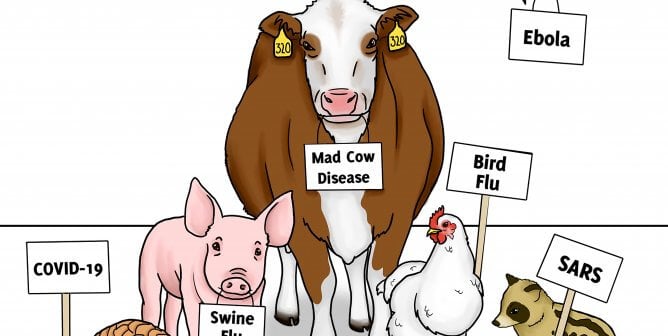8 Ways for Teachers to Advocate for Animals While Staying Home
The classroom is an important forum for humane educators when it comes to animal activism and the opportunity to teach students to be compassionate citizens. But with quarantine measures in place around the country, we’re all navigating a new normal, and most animal-friendly teachers are adjusting to virtual classrooms and developing distance-teaching methods.
It can be challenging to stay connected with your mission to help animals and prioritize humane education in the midst of the COVID-19 crisis, but there are lots of ways to do it—on your own as well as with your students. As members of society, we’re being called upon to come up with creative ways to conduct our affairs safely in the midst of a pandemic. But as animal advocates, we’re also being called upon to come up with creative ways to speak up for animals.
The good news is that virtual classroom teaching doesn’t mean that you have fewer opportunities to speak up for animals. There are plenty of easy, creative, compassionate, effective ways to advocate for animals from home—with your students and in general. Keep up your own morale while also fighting for the animals who need your help by integrating some of these compassionate practices into your quarantine lifestyle.
1. Take Action on Important Alerts for Animals—Right From Your Phone
Each month, PETA compiles its top 10 most urgent campaigns for animals so that you can take action on them quickly and at your leisure. The rapid-action center pages make it easy to advocate for animals and make a difference on urgent issues without leaving your home. All you need is a few minutes and your phone.

2. Watch an Animal-Friendly Film (or Stream One With Your Students)
Activism comes in many different forms, and sometimes it’s as simple as watching animal-friendly movies with the members of your household and having meaningful conversations about them afterward. Or if you’re looking to relax solo, brush up on your own animal rights knowledge by watching something on your own. And because most kids are spending their free time at home time, too, this is the perfect time to assign some extra-credit opportunities centering around animal-friendly films for students that they can watch via popular streaming services.

3. Use a Virtual Zoom Background With a Pro-Animal Message
Using Zoom to have meetings with colleagues or students from home? Or perhaps just to catch up with friends and family? Speak up for animals while staying connected by using one of PETA’s free Zoom backgrounds. There are more than 15 to choose from, and they all feature vegan and cruelty-free messages. (And we bet your students will like them, too!)

4. Start an Animal Rights–Themed Virtual Book Club
With a little extra time on our hands to catch up on pleasure reading, why not add elements of social connection and animal activism by starting an animal rights–themed book club with friends, family, colleagues, or interested students? There are loads of books with pro-animal messages to choose from. And if you want something hot off the press, check out PETA President Ingrid Newkirk’s new book, Animalkind: Remarkable Discoveries About Animals and Revolutionary New Ways to Show Them Compassion, cowritten with bestselling author Gene Stone—then watch her discussion of the book virtually.
5. Give Yourself (and Your Students) Some Animal-Friendly Art Therapy
In the midst of a stressful time, it’s a good idea to put our worries aside and take some time to do something simple and therapeutic, such as coloring. PETA’s River Phoenix–inspired adult coloring sheet is adorable and fun to fill in—and you can share your gorgeous and unique finished product on social media to help raise awareness. Share this sheet with older students, too—and if you work with younger kids, send them PDF copies of TeachKind’s student coloring sheets for some at-home fun.

6. Try a New Vegan Recipe—and Brag About It on Social Media!
While social distancing may prevent us from sharing meals with friends, colleagues, and students, we can still share photos of luscious vegan meals, which can show people how simple and delicious vegan cooking is. Browse PETA’s vegan recipe database and find something that calls for ingredients that you have on hand, then share photos of the meal (plus the recipe) with your social network.

7. Make the Most of Your Screen Time With PETA’s App
Let’s be honest—we’re all watching our screen time increase as we shelter in place. But we don’t have to waste that time idly scrolling. Download PETA’s iPhone/iPad app, which gives you a fast and easy way to help animals anytime. With this app in the palm of your hand, you can take action for animals whenever you have a spare moment, with just a quick tap on your phone or iPad.
8. Make Sure Your Self-Care Routine Is Cruelty-Free—Then Pamper Yourself
Self-care during times of crisis is a must, as we’re all trying to stay healthy, conscious, and sane. But why not give it an animal-friendly and cruelty-free twist? Check out TeachKind’s animal-friendly self-care tips for teachers to give yourself some major inspiration and get some “you time” worked into your schedule.

*****
Teaching from home? TeachKind has you covered with lots of online lesson plans, distance-teaching tools, and free classroom materials that promote humane education and compassion for animals—at all grade levels.
As an Amazon Associate, PETA earns from qualifying purchases. If you buy something after clicking the Amazon links on this page, a percentage of the qualifying purchase will be donated to PETA and help us protect more animals from exploitation.



